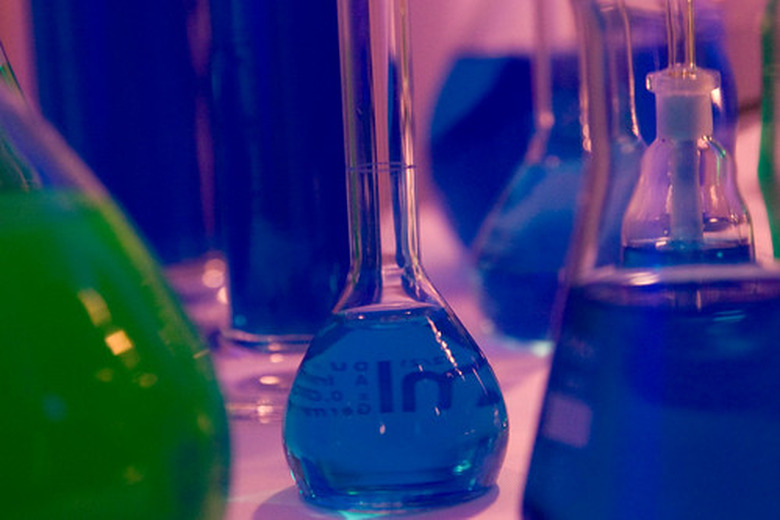Chemicals Used In Chemistry In High School
The chemicals used in high school chemistry don't differ much from those used in any chemistry lab. The difference in environment does, however, affect their rate of use, potential for causing hazardous situations and purpose for usage. When purchasing, instructing and conducting experiments with chemicals, safety precautions and proper waste disposal are essential.
Types of Chemicals
Types of Chemicals
Chemicals commonly found in a high school laboratory should be stored and classified as inorganic or organic. Inorganic substances commonly found in a high school laboritory include sulfates, carbonates, nitrides, peroxides, borates and acids (except Nitric Acid). Organic substances include:
- some acids
- alcohols
- esters
- ethers
- sulfides
- phenols
Within the organic and inorganic substance categories, certain substances cannot be stored near water or other compounds. Chemical lab safety manuals should be consulted before storing chemicals in a high school laboratory.
Storage
Storage
Acids should be stored in a cabinet separated from all other compounds. Nitric acid should be stored away from any other acids, unless the dedicated acids cabinet has a separate compartment. Chemicals must be organized by compatibility, meaning highly volatile substances should never be stored near other compounds that could cause a reaction. Cabinets with volatile substances should be well ventilated. Toxic chemicals should be stored in a poison cabinet that is clearly labeled with a visible sign on the outside of the cabinet. This cabinet should remain locked at all times and only opened at the instructor's discretion. Obtain a flammable liquid storage cabinet for all flammable materials.
Reducing Waste
Reducing Waste
Waste and/or pollution is always a concern when amounts of any potentially hazardous substance are used, experimented with, then disposed of. Many high school teachers substitute hazardous chemicals with less toxic chemicals that will produce the same (though scaled down) chemical reactions. Amounts of chemicals can be scaled down as well to prevent producing excess waste as chemicals and an experiment are performed by hundreds of students in a single day. Demonstration videos can eliminate waste altogether by showing an experiment and its resulting reaction without actually performing it.
Substitutions
Substitutions
In order to keep the classroom environment safe, many teachers substitute volatile chemicals for those that are less volatile. For example, digital thermometers remove the threat of a broken mercury thermometer. Copper carbonate is an acceptable substitute for lead chromate and there are many others available as well. Often, common household items, such as hydrogen peroxide, or dish soap, contain all of the elements necessary to perform an experiment without creating a hazardous learning environment.
Waste Disposal
Waste Disposal
Different states have regulations about waste disposal. In general, a waste is considered hazardous if it is intangible, corrosive, toxic or reactive. There are special guidelines provided by the EPA for disposal of these wastes. All others must be disposed of in an appropriate and preferably biodegradable container. There are also procedures for rendering toxic waste nontoxic. Each chemical is different, but, often, a potentially hazardous product can be made safe with the addition of a few chemicals and proper disposal.
Common Experiments
Common Experiments
Most experiments found in high school chemistry labs result in products that surprise or amuse high school age students. Some common experiments include those where students create a sticky polymer using food coloring, guar gum and Borax. Another has them creating rock crystals using cane sugar and water. Yet another popular high-interest experiment uses baking soda, lye, zinc, vinegar and HCl to create different chemical reactions. Students generally respond best to experiments that yield immediate and familiar results.
Cite This Article
MLA
Barrus, Julia. "Chemicals Used In Chemistry In High School" sciencing.com, https://www.sciencing.com/chemicals-used-chemistry-high-school-5559273/. 24 April 2017.
APA
Barrus, Julia. (2017, April 24). Chemicals Used In Chemistry In High School. sciencing.com. Retrieved from https://www.sciencing.com/chemicals-used-chemistry-high-school-5559273/
Chicago
Barrus, Julia. Chemicals Used In Chemistry In High School last modified August 30, 2022. https://www.sciencing.com/chemicals-used-chemistry-high-school-5559273/
